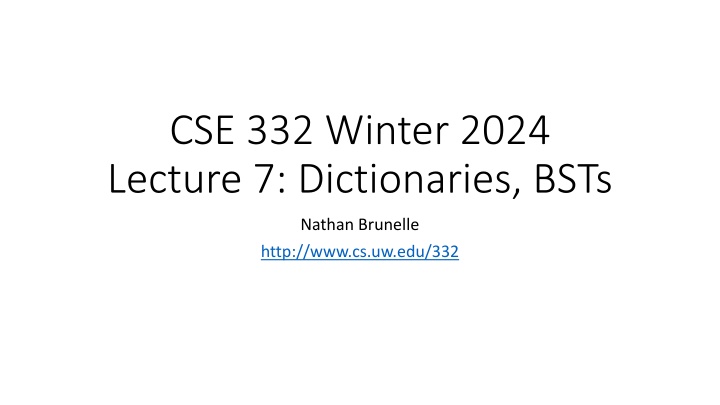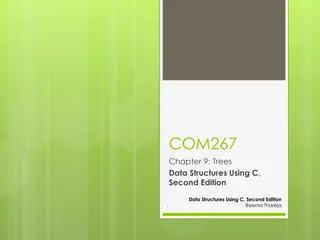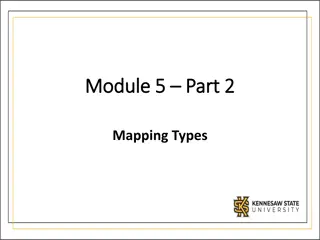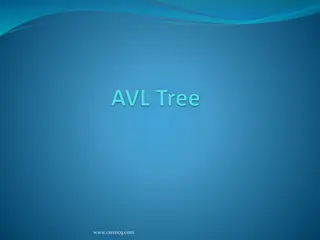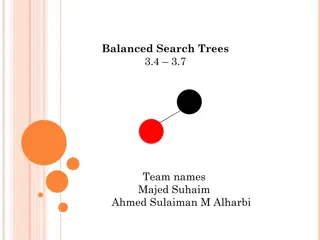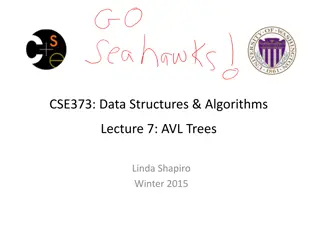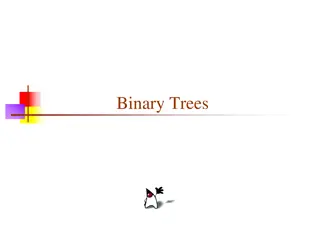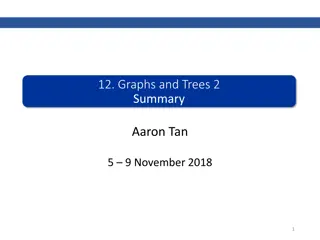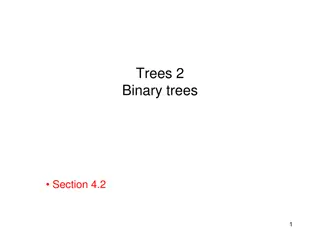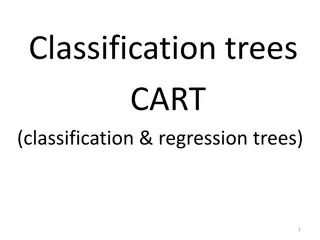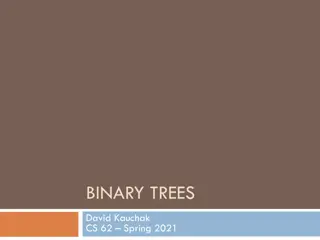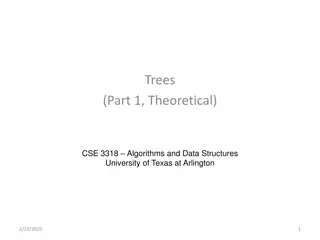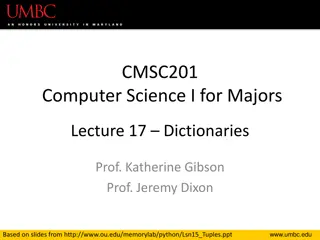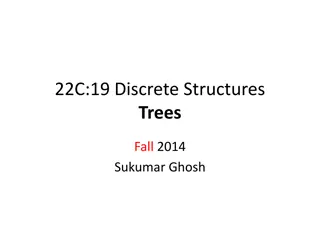Dictionaries and Binary Trees Overview
This content provides an overview of dictionaries (Map ADT) and binary search trees (BSTs), including operations, comparisons between different implementations, naive data structure attempts, and upcoming topics in the course. It discusses methods to build binary heaps within unordered arrays, dictionary operations like insert, find, and delete, and compares data structure efficiency in terms of time to insert, find, and delete. The material also touches on tree height calculations and upcoming topics like AVL trees and hash tables.
Download Presentation

Please find below an Image/Link to download the presentation.
The content on the website is provided AS IS for your information and personal use only. It may not be sold, licensed, or shared on other websites without obtaining consent from the author.If you encounter any issues during the download, it is possible that the publisher has removed the file from their server.
You are allowed to download the files provided on this website for personal or commercial use, subject to the condition that they are used lawfully. All files are the property of their respective owners.
The content on the website is provided AS IS for your information and personal use only. It may not be sold, licensed, or shared on other websites without obtaining consent from the author.
E N D
Presentation Transcript
CSE 332 Winter 2024 Lecture 7: Dictionaries, BSTs Nathan Brunelle http://www.cs.uw.edu/332
Warm Up: Tree Method ? 2 + 4?2 ? ? = 2? Red box represents a problem instance Blue value represents time spent at that level of recursion 4?2 ? 4?2 4? work at level ? 4?2 4?2 ? 2 ? 2 4 4 4?2 16 4?2 16 4?2 16 4?2 16 ? 4 ? 4 ? 4 ? 4 log2? levels of recursion 1 1 1 1 1 1 1 1 1 1 1 1 log2? log2?1 4?2 4?= 4?2 4?= (?2) ? ? = ?=1 ?=1
Warm Up: Which is better? Both of the following build a binary heap within an unordered array. Which is better? 5 Parents where Heap Property is Violated buildHeapDown(arr){ for(int i = arr.length; i>0; i--){ percolateDown(arr, i); } } 0 10 6 2 1 8 7 3 15 5 6 3 4 buildHeapUp(arr){ for(int i = 0; i<arr.length; i++){ percolateUp(arr, i); } } 1 14 2 9 7 8 5 6 10 3 15 8 7 14 2 1 0 1 2 3 4 5 6 7 8 9
Dictionary (Map) ADT Contents: Sets of key+value pairs Keys must be comparable Operations: insert(key, value) Adds the (key,value) pair into the dictionary If the key already has a value, overwrite the old value Consequence: Keys cannot be repeated find(key) Returns the value associated with the given key delete(key) Remove the key (and its associated value)
Nave attempts Data Structure Time to insert Time to find Time to delete (?) (?) (?) Unsorted Array (?) (?) (?) Unsorted Linked List ? (log?) (?) Sorted Array ? ? ? Sorted Linked List
Less Nave attempts Binary Search Trees (today) Tries (Project) AVL Trees (next week) B-Trees (next week) HashTables (week after) Red-Black Trees (not included in this course) Splay Trees (not included in this course)
Nave attempts Data Structure Time to insert Time to find Time to delete (?) (?) (?) Unsorted Array (?) (?) (?) Unsorted Linked List ? (log?) (?) Sorted Array ? ? ? Sorted Linked List ? ? ? Binary Search Tree (W.C.) (log?) (log?) (log?) Binary Search Tree (average)
Tree Height treeHeight(root){ height = 0; if (root.left != Null){ } if (root.right != Null){ height = max(height, treeHeight(root.right)); } return height; } height = max(height, treeHeight(root.left));
More Tree Vocab D U B Traversal: An algorithm for visiting/processing every node in a tree Pre-Order Traversal: Root, Left Subtree, Right Subtree S 2 In-Order Traversal: Left Subtree, Root, Right Subtree Post-Order Traversal Left Subtree, Right Subtree, Root
Name that Traversal! BorderTraversal(root){ process(root); if (root.left != Null){ } if (root.right != Null){ } } CorderTraversal(root){ if (root.left != Null){ } process(root) if (root.right != Null){ } } AorderTraversal(root){ if (root.left != Null){ } if (root.right != Null){ } process(root); } process(root.left); process(root.left); process(root.left); process(root.right); process(root.right); process(root.right);
7 Binary Search Tree 10 3 8 16 1 6 Binary Tree Definition: Order Property All keys in the left subtree are smaller than the root All keys in the right subtree are larger than the root 0 2 Why?
7 Are these BSTs? 10 3 7 7 16 1 10 3 0 16 16 1 10 0 7 7 10 3 3 8 16 1 1 0 0
7 Find Operation (recursive) find(key, root){ if (root == Null){ return Null; { if (key == root.key){ return root.value; } if (key < root.key){ return find(key, root.left); } if (key > root.key){ return find(key, root.right); } return Null; } 10 3 6 16 1 0
7 Find Operation (iterative) find(key, root){ while (root != Null && key != root.key){ if (key < root.key){ root = root.left; } else if (key > root.key){ root = root.right; } } if (root == Null){ return Null; } return root.value; } 10 3 6 16 1 0
7 Insert Operation (iterative) insert(key, value, root){ if (root == Null){ this.root = new Node(key, value); } parent = Null; while (root != Null && key != root.key){ parent = root; if (key < root.key){ root = root.left; } else if (key > root.key){ root = root.right; } } if (root != Null){ root.value = value; } else if (key < parent.key){ parent.left = new Node(key, value); } else{ parent.right = new Node (key, value); } } 10 3 6 16 1 0 Note: Insert happens only at the leaves!
9 Delete Operation (iterative) delete(key, root){ while (root != Null && key != root.key){ if (key < root.key){ root = root.left; else if (key > root.key){ root = root.right; } } if (root == Null){ return; } // Now root is the node to delete, what happens next? } 10 3 6 16 1 } 5 7 0
9 Delete 3 Cases 10 3 0 Children (i.e. it s a leaf) 6 16 1 5 7 0 1 Child 2 Children
9 Finding the Max and Min 10 3 maxNode(root){ } Max of a BST: Right-most Thing if (root == Null){ return Null; } while (root.right != Null){ root = root.right; } return root; 6 16 1 5 7 0 Min of a BST: Left-most Thing minNode(root){ } if (root == Null){ return Null; } while (root.left != Null){ root = root.left; } return root;
9 Delete Operation (iterative) delete(key, root){ while (root != Null && key != root.key){ if (key < root.key){ root = root.left; } else if (key > root.key){ root = root.right; } } if (root == Null){ return; } if (root has no children){ make parent point to Null Instead; } if (root has one child){ make parent point to that child instead; } if (root has two children){ make parent point to either the max from the left or min from the right } } 10 3 6 16 1 5 7 0
Worst Case Analysis For each of Find, insert, Delete: Worst case running time matches height of the tree What is the maximum height of a BST with ? nodes?
Improving the worst case How can we get a better worst case running time?
Balanced Binary Search Trees We get better running times by having shorter trees Trees get tall due to them being sparse (many one-child nodes) Idea: modify how we insert/delete to keep the tree more full
Idea 3: Both Subtrees of every Node have same # Nodes
Idea 4: Both Subtrees of every Node have same height
Teaser: AVL Tree A Binary Search tree that maintains that the left and right subtrees of every node have heights that differ by at most one. Not too weak (ensures trees are short) Not too strong (works for any number of nodes)
